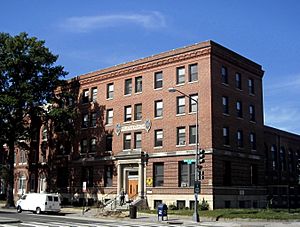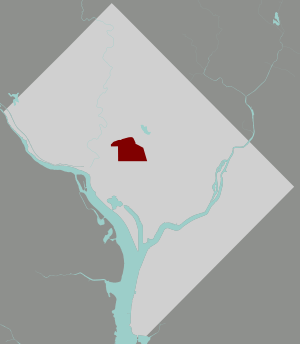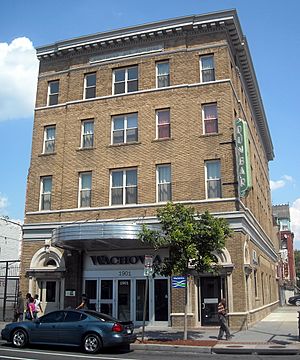Shaw (Washington, D.C.) facts for kids
Quick facts for kids
Shaw, Washington, D.C.
|
|
|---|---|
|
Neighborhood of Washington, D.C.
|
|

The Phillis Wheatley YWCA, built in 1920, is listed on the National Register of Historic Places
|
|

Shaw within the District of Columbia
|
|
| Country | |
| District | |
| Ward | Wards 1, 2, and 6 |
| Named for | Shaw School, named for Robert Gould Shaw |
| Area | |
| • Total | .73 sq mi (1.9 km2) |
| Population
(2010)
|
|
| • Total | 17,639 |
| • Density | 24,163.0/sq mi (9,329.4/km2) |
Shaw is a lively neighborhood in the Northwest part of Washington, D.C.. For a long time, Shaw and the U Street Corridor have been important centers for Black social life, culture, and business in the city. Many important events in the fight for fairness and equality happened here. This includes visits from leaders like Martin Luther King Jr. and Malcolm X. Shaw is also home to several historic places. The city has named much of it the Shaw Historic District.
Contents
How Shaw Got Its Name

Before the 1960s, this area was known as Midcity. In 1966, city planners used the boundaries of Shaw Junior High School to define a large area for new development. This area included what we now call Shaw, the U Street Corridor, and Logan Circle.
The school was named after Robert Gould Shaw. He was a brave leader of the 54th Massachusetts Infantry Regiment. This was one of the first official African American military units during the American Civil War. Over time, as the area changed, people started using more specific names for different parts. But "Shaw" remained the clear name for the central part of the neighborhood.
Exploring Shaw's Geography
Shaw is located in the heart of Washington, D.C. It is surrounded by several other neighborhoods. To the north, you'll find Florida Avenue NW, the U Street Corridor, Ledroit Park, and Howard University. To the south, it's bordered by M Street NW, Massachusetts Avenue NW, Mount Vernon Square, and Downtown Washington, D.C.. On the east, you'll find First St. NW and Truxton Circle. To the west, it's 12th Street NW, the U Street, and Logan Circle.
Shaw has a grid of streets. Most of the buildings are small Victorian-style row houses. You can also find newer apartment buildings and mixed-use developments. The main shopping areas used to be along 7th and 9th streets NW. Today, these streets still have many small businesses. But now, you'll find trendy shops and restaurants. Hidden in the alleys are old industrial buildings. These are now part of the Blagden Alley-Naylor Court Historic District. They house cool restaurants, cafes, and other small businesses.
A Look at Shaw's History
Shaw started as camps for freed slaves on the edge of Washington, D.C. It was once called "Uptown." This was because the city's boundary used to be "Boundary Street," which is now Florida Avenue.
In the late 1800s and early 1900s, Shaw became a very important place for Black thinkers and artists. It was a national center for Black culture even before the Harlem Renaissance. During this time, Howard University was founded. Famous people like Professor Alain LeRoy Locke and writer Langston Hughes were connected to this area. The famous jazz musician Duke Ellington was also from Shaw.
After the death of Martin Luther King Jr. in 1968, some parts of D.C., including Shaw, experienced unrest. This led to a period where the neighborhood faced challenges. Many buildings were damaged, and the area saw less investment. However, community leaders like Walter Fauntroy and Watha T. Daniel worked hard to rebuild Shaw. They started projects to help the community recover and grow.
Shaw is mostly known for its 19th-century Victorian row houses. These beautiful homes, along with Shaw's central location, have made the neighborhood very popular. This has led to changes, with new people moving in and new businesses opening. This mix of new and long-time residents has created interesting discussions about the neighborhood's future.
Important Places and Transportation
Getting Around Shaw
Shaw is easy to get to using public transportation. The Washington Metro Green and Yellow lines have stops at Shaw-Howard University Station, U Street Station, and Mount Vernon Square Station. There are also several bus routes that connect Shaw to other parts of the city. For example, the G2 bus goes between Georgetown University and Howard University.
Shaw has a high "Transit Score" of 80. This means it's very convenient to use public transit for most trips. You can reach the White House in about 10 minutes by public transit. Reagan National Airport is about 28 minutes away by public transit.
Cultural Spots to Visit
Shaw has many interesting cultural landmarks:
- Howard Theatre: This historic theater was once called the "largest color theater in the World." It hosted many famous Black artists. After being restored, it still hosts performers today.
- Dunbar Theater: This theater, also known as the Southern Aid Society, was a popular place for live shows and movies. It opened in the 1920s and is now on the National Register of Historic Places.
- CityMarket at O: This building, once called "O Street Market," is a beautiful historic landmark. It's one of the few public market buildings left from the 1800s in D.C.
- The Shiloh Baptist Church: This church helps the Shaw community in many ways. Even President Barack Obama and his family attended an Easter service here in 2011.
- The Watha T. Daniel/Shaw Neighborhood Library: This modern library was updated in 2010. Its design has won several awards and was even named one of the top buildings of 2010 by The Wall Street Journal.
- The Walter E. Washington Convention Center: A large part of this huge center is in Shaw. It has hosted many big events, including some with President Barack Obama. It's also known for being eco-friendly.
Parks and Fun Places
Shaw has several parks and recreation centers for outdoor activities:
- Shaw Park
- Shaw Dog Park
- Cardozo Recreation Center
- Kennedy Recreation Center (which has a baseball field)
- Bundy Field
- Bundy Dog Park
Shaw's Population
Shaw's population has changed a lot over the years. In 1950, over 34,000 people lived here. Like many D.C. neighborhoods, Shaw's population went down in the 1980s and 1990s. But it has grown quite a bit since the year 2000, reaching 17,639 people in 2010.
Shaw has always been home to many African Americans. Today, it continues to be a diverse neighborhood. Many new apartment buildings have been built, and housing prices have been increasing.
Little Ethiopia
Little Ethiopia is a special part of the Shaw neighborhood. It's located around 9th and U Street Northwest. This area is known for having many Ethiopian businesses and residents.
Since the 1980s, Ethiopian business owners have bought properties in this part of Shaw. The area has become very popular, even outside the Ethiopian community. Many people, both locals and tourists, come to Shaw to try the delicious Ethiopian restaurants. This has helped to bring new life to the area. Some people in the Ethiopian American community have suggested officially calling this area "Little Ethiopia." However, some long-time Shaw residents are not sure about this idea. They worry it might separate this area from the rest of Shaw's historic African American identity.
Education in Shaw
The District of Columbia Public Schools system runs the public schools in Shaw. The District of Columbia Public Library operates the Watha T. Daniel/Shaw Community Library, which is a great resource for learning and reading.


